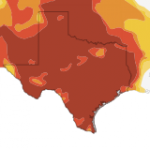The Texas Drought Could Be Ending, Thank God. (And Thank Rick Perry?)

Photo by Brandon Thibodeaux/Getty Images
Texas Governor Rick Perry speaks to an estimated 30,000 attendees at the non-denominational prayer and fasting event, "The Response," on August 6, 2011 in Houston, Texas.
Texas has come a long way in recovering from the devastating single-year drought of 2011. The latest US Drought Monitor Map out this week shows that more than 11 percent of the state is completely drought-free. And less than 5 percent of the state is in the worst stage of drought. By comparison, a year ago, more than 88 percent of the state was in that “exceptional” drought stage.
Since then, things have drastically improved. And during a conference call this week with the prayer campaign 40 Days to Save America, former pastor and Christian fundamentalist Rick Scarborough credited Texas Governor’s Rick Perry’s call to prayer a year ago for ending the drought. Last August, Perry led a prayer and Bible reading at ‘The Response,’ a prayer meeting of some 30,000 to 40,000 people at the massive Reliant Stadium in Houston. And apparently it worked?
“The press was willing to mock the prayer and fasting,” Scarborough says in the call featuring Perry, which you can listen to here, “but failed to document that — what everyone had thought would take years — to replenish our lakes and streams — almost happened in three months.” Scarborough says farmers have had a record year of hay harvest (actually, they haven’t) and that it all goes back “to the courageous call of a governor of a state to the people to pray and fast.”
However, many lakes and streams in Texas are very, very far from replenished.

Map by Texas Tribune
Texas' reservoirs have a long way to go to recover from drought, as you can see in this latest map of lake levels from the Texas Tribune.
O.H. Ivie, the main reservoir for several West Texas towns, is less than 12 percent full. It’s been falling all year. San Angelo has less than a year of water left. E.V. Spence Reservoir, which used to supply the town of Robert Lee, is still empty. The Highland Lakes, the main reservoirs for Central Texas, are less than half full. And a new report this week by Texas A&M Agrilife Today warns that “South Texas reservoir levels are low and keep dropping.” Amistad and Falcon Lakes, which make up the water supply for farmers and municipalities along the South Texas border, are at a combined 44 percent of capacity.
State Climatologist John Nielsen-Gammon (a Perry appointee) says that it could take years for Texas’ reservoirs to recover.
“Hydrologic impacts — water supply, reservoirs, stream flow — tend to be most sensitive to longer timescales because, for example, reservoirs hold multiple years-worth of run off,” Nielsen-Gammon said in an interview with StateImpact Texas earlier this year. “And so the fact that the rainfall from the current year hasn’t made up for the deficit built up last year means there’s still hydrologic drought present in Central Texas.”
Last April, at the beginning of the most devastating wildfire season in Texas history, Perry declared a three-day “Prayer for Rain” in response. Months later, the Labor Day Wildfires ignited, destroying over 1,600 homes and taking two lives.
“Thank you for the leadership of our state,” the former pastor Scarborough says in the call.
Governor Perry didn’t get a chance to respond to Scarborough’s salutations, but he did take time earlier in the call to lambast the separation of church and state in remarks that got the governor back in the headlines after leaving the Republican primary in January.
“Satan runs across the world with his doubt and with his untruths and what have you,” Perry says in the call, “and one of the untruths out there … is that people of faith should not be involved in the public arena.”
While the drought isn’t over, it’s fair to say it’s headed right in that direction. The latest forecasts are calling for a cool, wet winter that could help Texas’ lakes and streams that still haven’t recovered.
But the issues of water management and conservation brought up by the drought aren’t likely going away anytime soon. And it’s fair to say we’re going to need more than prayers to tackle those issues in the future.



